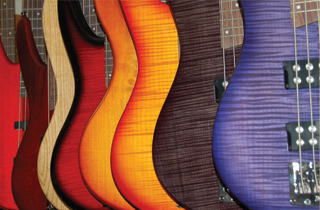
Sometimes the same old chords get… well, boring. Every guitar player can pick up an axe and hammer away at G, C and D in first position. When you sit around the campfire with your pickin’ and grinnin’ friends, spice up your strumming by layering the chords with different voicings.
What is voicing?
Have you ever noticed that two different people can sing the same song, hit all the exact same notes and sing with the same inflection, but somehow the song sounds very different? It’s not necessarily due to differences in singing style. Everyone’s voice has unique characteristics to it. These characteristics color the sound of the pitches. Though they sing the exact same notes, these two vocalists sound very different due to the uniqueness of their voices.
Every guitarist begins by learning chords in first position. These same chords can be played in various places all over the neck, using almost all of the exact same pitches. Though these chords are technically the same, they will sound very different because of a combination of several variables: thickness of the strings being played, construction of the strings being played, length of string being vibrated, number of fretted notes versus open notes, etc. Just like the unique sound of two different human voices, two chord that are the same but being played in different places on the neck are said to have different voicings.
How do you use different chord voicings?
When your buddy pulls out his guitar and starts playing G, C and D in first position, find those chords somewhere else. It is called layering when two guitars play the same chords with different voicings. Start by layering open chords with standard triad barre chords. The E and A shape barre chords get used most frequently by guitarists. You can also try C or D shape barre chords.
Experiment with simplified or partial chords. Most guitar triads have several repeated notes. Slim the chord down to just the three necessary notes. Try power chords, power chord inversion or double stops in different places along the neck. Arpeggiated chords also add a more interesting layer to your rhythm guitar playing.
Another fun way to layer chords is to capo the guitar and use open chord shapes that are different from the ones used in first position but still play all the same notes in the chords. For instance, you could capo at the fifth fret and play the D, G and A shapes. Because the capo moves every chord up five half steps when capoed at the fifth fret, the D shape now plays a G major chord, the G shape plays a C major and the A shape plays a D major.
Learn as many chord forms as you can. The more voicings that you know, the more options you have for layering. For a more technical look at the difference between pitches when played in various places on the acoustic and electric guitars, check out “The Sight of Sound in Music” by Robbie Pitts.